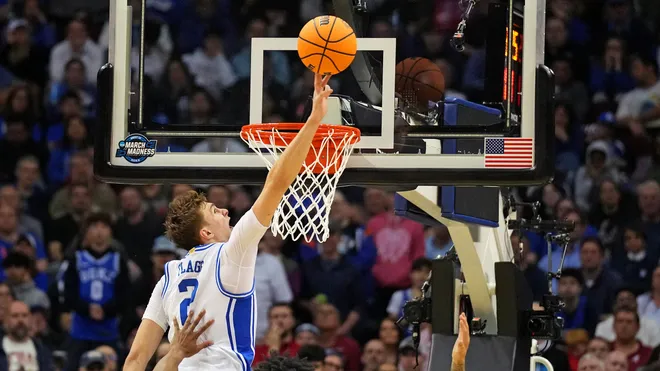KenPom narrowly favors Duke basketball over Houston in the Final Four of March Madness

As March Madness reaches its climax with the Final Four, excitement and tension are building as the best teams in college basketball prepare for their shot at the ultimate prize: a national championship. This year, one of the most anticipated matchups is between two powerhouse programs—Duke University and the University of Houston. Both teams have navigated the rigorous path through the NCAA Tournament with poise and dominance, but now, in the high-stakes environment of the Final Four, they’ll face off in what promises to be an electrifying contest.
While both teams boast impressive talent, coaching, and track records, one of the most respected analytical tools in basketball, KenPom, has weighed in on the matchup and provided a narrow favor to Duke over Houston. This ranking is not just a result of gut feeling or intuition—it’s based on a comprehensive statistical breakdown of both teams’ performances throughout the season, factoring in offensive and defensive efficiency, tempo, strength of schedule, and other key metrics. KenPom’s system, which uses advanced analytics to measure teams’ overall performance, has become a trusted resource for basketball experts and fans alike, providing insight into how teams match up against one another.
In this article, we will explore the reasons behind KenPom’s narrow favoring of Duke over Houston in the Final Four, analyzing the strengths and weaknesses of both teams, key individual matchups, and how statistical factors may influence the game’s outcome. As we dig into the intricacies of this matchup, we’ll break down what makes Duke slightly more favored than Houston, even in such a tightly contested battle.
KenPom’s Analytical Approach: A Look at the Metrics
KenPom.com, founded by basketball analyst Ken Pomeroy, is known for its advanced statistics and rankings that provide a comprehensive look at team performance. The rankings are based on several factors, with the two most important metrics being offensive efficiency and defensive efficiency. Offensive efficiency measures how many points a team scores per 100 possessions, while defensive efficiency measures how many points a team allows per 100 possessions. The goal is to evaluate how efficient a team is at both scoring and preventing scoring.
KenPom also incorporates adjusted tempo, which accounts for how fast or slow a team plays relative to the rest of the field. Teams that play at a faster tempo tend to create more possessions, which can lead to higher-scoring games. Other important metrics include turnover percentage, effective field goal percentage, and free throw rate. KenPom’s rankings are designed to provide a holistic view of a team’s performance, allowing for a fair comparison between teams regardless of their playing style or pace.
Duke’s Strengths: Elite Offensive Efficiency
Duke University, under the leadership of head coach Jon Scheyer, has been one of the top teams in the country this season. The Blue Devils have managed to excel on both sides of the ball, with a particular emphasis on their offensive efficiency. KenPom ranks Duke’s offense among the top 10 in the nation, a testament to their scoring ability and offensive depth.
Duke’s offensive strength is centered around their balance and versatility. The Blue Devils have several players who can score in a variety of ways, from knockdown shooters to dominant post players. One of the keys to Duke’s success has been their ability to create efficient offense through both half-court sets and transition play. The Blue Devils excel at spacing the floor, allowing their shooters to get open looks while also opening up lanes for their big men to operate in the paint.
The team is led by freshman sensation Kon Knueppel, whose offensive prowess has been a game-changer for the Blue Devils. Knueppel’s ability to score from anywhere on the floor, along with his advanced basketball IQ, has made him a focal point of Duke’s offensive attack. Alongside Knueppel, Duke has multiple players capable of stepping up and making a difference, including guard Tyrese Proctor and forward Kyle Filipowski, both of whom provide scoring and playmaking ability. This depth of talent gives Duke the ability to adjust its offense depending on the opponent, creating matchup problems for any team they face.
In terms of efficiency, Duke is excellent at maintaining a high shooting percentage, with their effective field goal percentage ranked among the top teams in the country. This efficiency is largely due to their ability to get high-percentage shots, both from inside the paint and from beyond the arc. In addition, Duke’s offensive rebounding ability provides them with second-chance opportunities, allowing them to extend possessions and accumulate more scoring chances. These offensive strengths are why KenPom has favored Duke in the matchup, as the Blue Devils have been able to execute at a high level throughout the tournament.
Houston’s Defensive Strengths: A Challenge for Duke’s Offense
While Duke has been exceptional offensively, Houston presents one of the most formidable defensive units in college basketball. The Cougars, coached by Kelvin Sampson, are known for their aggressive and suffocating defense, which has been the backbone of their success throughout the season. Houston’s defense is ranked among the best in the country according to KenPom’s metrics, and it’s no surprise that they are known for their ability to disrupt opposing offenses.
Houston’s defensive strength lies in their ability to force turnovers, defend without fouling, and contest shots at the rim. The Cougars excel at creating chaos in passing lanes, leading to steals and fast-break opportunities. This relentless pressure often results in teams struggling to execute their offensive sets, and it has been a key reason why Houston has been so effective in the tournament.
One of the key players for Houston is Marcus Sasser, a lockdown defender who has the ability to guard multiple positions on the floor. Sasser’s defensive abilities, combined with his scoring prowess, make him one of the most complete players in the tournament. Houston also boasts several other strong defenders, including J’Wan Roberts and Taze Moore, who contribute to their team’s stingy defense. This suffocating defense has allowed Houston to limit opponents’ scoring and dictate the tempo of games.
However, despite Houston’s elite defense, they face a significant challenge in containing Duke’s offensive firepower. Duke’s balance and versatility on offense make it difficult for any team to fully neutralize their attack, and the Blue Devils have proven throughout the tournament that they can adjust their strategy when needed. Still, Houston’s defense will certainly pose a significant challenge for Duke’s offense, forcing the Blue Devils to execute with precision and composure.
Key Matchup: Duke’s Offensive Firepower vs. Houston’s Defensive Pressure
The primary matchup that will determine the outcome of this Final Four game will be Duke’s ability to score efficiently against Houston’s defense. On paper, KenPom’s ranking of Duke as the slightly more favored team suggests that the Blue Devils have the edge in terms of overall offensive execution. However, Houston’s defense is anything but ordinary, and they have the ability to disrupt Duke’s offensive flow. If Houston can stifle Duke’s key players, like Kon Knueppel and Tyrese Proctor, and force the Blue Devils into difficult shots, the Cougars will be well-positioned to take control of the game.
For Duke, one key to success will be their ability to move the ball efficiently and find open looks. Houston’s defense thrives on creating chaos, but Duke’s offensive structure could mitigate some of that pressure. If the Blue Devils can handle Houston’s defensive intensity and maintain composure under pressure, they should be able to find ways to score.
On the other hand, Houston will need to make sure that their offense keeps pace with Duke’s scoring ability. While Houston is known for its defense, they are also capable of scoring efficiently, especially with Marcus Sasser leading the charge. The Cougars will need to find ways to exploit Duke’s defensive weaknesses and take advantage of every possession.
KenPom’s Narrow Favor: Why Duke Holds the Edge
KenPom’s analysis of the matchup shows that while both teams are evenly matched in many aspects, Duke’s slight edge comes from their overall offensive efficiency. KenPom’s model has consistently ranked Duke as one of the top offensive teams in the country, and their balanced scoring attack gives them an advantage over Houston’s more defense-oriented approach.
In a matchup as close as this, the small details matter. Duke’s ability to execute offensively, their depth of talent, and their ability to adjust to different game scenarios give them a slight advantage in this game. However, it’s important to note that Houston’s defense can swing the game in their favor if they manage to disrupt Duke’s offensive flow. Ultimately, it’s going to come down to which team can impose their style of play on the other.









